Mayor Choi Sung meets with Harvard and UCLA professors
Goyang City is working hard to promote the “Goyang Global Economic Network” in a bid to accelerate its development in various fields.
In November 2011, Choi Sung, mayor of Goyang, a major city of over 1 million inhabitants, toured North/Latin America. He discussed with administrators of Harvard University and UCLA about student exchange programs. Discussions were also focused on ways to innovate the education program for Goyang's civil servants and the possibility of hosting international academic forums in the Korean city. There has been substantial progress in the issues, according to Goyang officials.
Of note, Mayor Choi met with internationally known professors Edward J. Baker (Harvard University) and John Duncan (UCLA) to discuss about how Goyang could adapt to advanced educational systems and innovate its education and training programs. The professors visited Goyang City in June 2012 to deliver lectures for civil servants in charge of education and administrators of colleges based in the city.
The Goyang delegation, led by Mayor Choi Sung, met with American businessmen and Korean-Americans in an effort to activate a “Goyang Global Economic Network.” The delegation sought to promote the Goyang International Flower Festival and the city’s medical tourism.
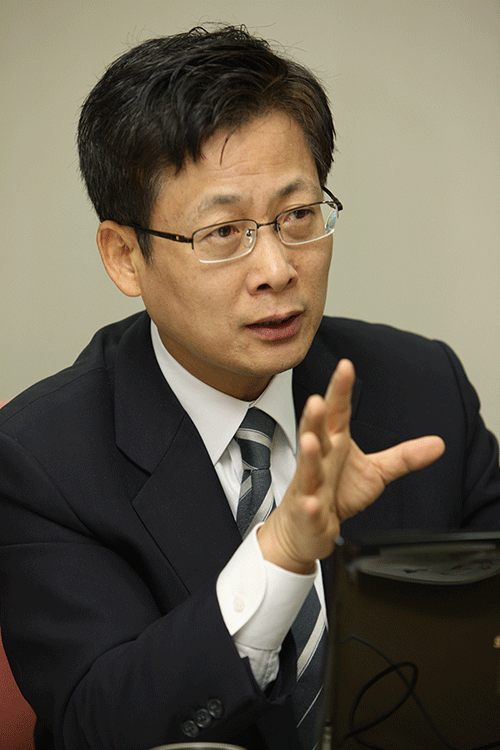
Mayor Choi, 51, talked with Washington D.C. Loudoun County Mayor Kristen Umstead to discuss about student exchange programs. Mayor Kristen promised to sign an MOU on a student exchange program between the two cities once the plan was approved by the city council. As a result, there were expectations that the two cities would initiate exchange programs related to civil aviation education at college-level and elementary and secondary school pupils at an early date.
Notably, Mayor Choi visited the U.S. Department of State for the first time as chief of a Korean self-governing entity. Officials whom he met promised to render support to educational exchange programs between Goyang and U.S. cities.
In Los Angeles, Mayor Choi visited the LA Area Commerce of Industry and met with Senior Vice President Carlos J. Valderraama. Valderraama leads the chamber’s global trade programs and spearheads advocacy efforts to bolster international trade, increase foreign direct investment and expand export opportunities for the greater Los Angeles region. He also met with Mark Jaffe, president of the Greater New York Chamber of Commerce and Ele Kauderer, professional real estate consultant who specializes in investment for Korea and other areas. Topics covered in their meetings were the Goyang Flower Festival and the city’s medical tourism initiatives. Valderraama reportedly showed keen interest in the Goyang Flower Show and promised to cooperate for promoting a Goyang Global Businessmen Network.
Choi, 51, earned his Ph.D. in political science from Korea University. He was reelected mayor of Goyang this year. He was first reelected to the mayorship in 2010.
“A Goyang Global Economic Network” was set up officially on October 1, 2011, by some 100 business persons based at home and abroad. The overseas businessmen of Korean origin came to Korea leading a group of sportsmen who were based in the United States, Canada and other foreign countries to participate in an annual national athletic event. There were in-depth discussions on how industrial and farm products of Goyang could make their way to the United States, especially New York City.

Rev. Park Sang-kyu, Hwang Won-kyun, former chairman of Virginia Korean Community, Lee Jong-guk, chief of Korean journalists based overseas and some others were additionally appointed as Goyang’s honorary international consultants based in Los Angles, Spain’s Catalan state, Mongolia, Japan’s Hokodate and Austria’s Eisenstadt. These international consultants are committed to working for the promotion of educational exchange projects between Goyang and these foreign cities and regions involved. Of note, the honorary consultants would exert special efforts to promote the Goyang Flower Festival and marketing of Goyang’s specialty products.
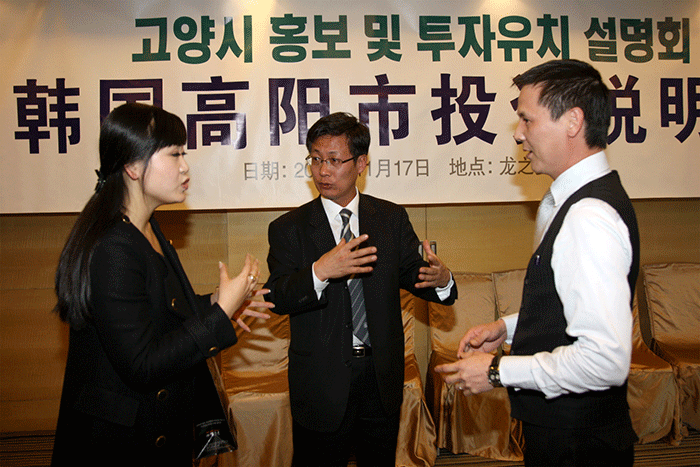
Mayor Choi met with California Irvine Mayor Sukhee Kang to talk about the city’s “Great Park” project and got a briefing from Kang in the development scene. The former Marine Corps Air Station El Toro is being transformed into the first great metropolitan park of the 21st Century--the Orange County Great Park. It is located in the geographic center of Orange County, California, halfway between Los Angeles and San Diego, spanning approximately 1,300 acres (nearly twice the size of New York’s Central Park) the Great Park’s award-winning master plan embraces environmental sustainability, preserves Orange County’s agricultural heritage, and honors the military history of the former air base, setting a new standard for sustainable park design and urban planning. Goyang City sought to learn a valuable lesson from the Great Park project in the development of Daegok (Subway) Station, and new towns.
Mayor Choi, who delivered a speech at Cambridge University when he visited the U.K., also conducted special lectures at Harvard University and UCLA, which reaffirmed his international stature. At UCLA, he spoke about “Korea’s political reality and leadership quality.” Prof. Edward Banker and some leading Korean-Americans were present when he spoke at Harvard’s Kennedy School about the “tributes of next (Korean) president.” The audience showed keen interest in Mayor Choi’s diagnosis of changing political scene of Korea.
He returned home after visiting Latin America where he also strove to promote the Goyang International Flower Festival and the Global Global Economic Network” which will likely weigh heavily on the development of Goyang whose population exceeded the 1 million mark of late.

The International Horticulture Goyang Korea 2014, which featured new flower species and flower planting technology, took place at Ilsan Lake Park in Goyang-si, Gyeonggi-do between April 25 and May 11. The flower festival produced significant results, even though the event was underway in a subdued mood amid the Sewol-ho ferry disaster.
Organized by the Goyang International Flower Foundation and Goyang City (40 minutes from Seoul Station via public transportation), the event has been held since 1997. More than 120 companies from 35 countries and 20 national pavilions participated in the 17-day flower festival.
The event highlights were the expansive display gardens located on the 37-acre site. Dozens of manicured flower beds were filled with blooming tulips, petunias and begonias (among scores of other varieties). In addition to the display gardens were five indoor exhibitions displaying both Korean and foreign flowers and plants, as well as cut flowers, succulents (cacti), bonsai, bulbs, ornamental trees and wild flowers. In total, more than 50 million flowers representing 5,000 species were presented at the festival.
Among the rare species which were on display were Rafflesia of Indonesia, the largest flower in the world which can grow to be 3 feet across and weigh up to 15 pounds, Silverswords of Hawaii, USA, giant roses of Colombia and Rainbow Tulips of the Netherlands.
The 'Garden of Hope Trees,' which was built in memory of victims of the Sewol-ho ferry disaster, attracted a steady stream of visitors as well.
The outdoor exhibition, including a large-scale flower gate in the form of a handshake, presented flower sculptures of diverse themes. Meanwhile, a number of hands-on programs, including a flower arrangement competition and a painting contest, were held to add excitement to the festival.
The event attracted roughly 430,000 visitors including those from abroad. Of note, the number of foreign visitors surged by nearly 100% over the previous year. Foreign visitors accounted for about 10% of total visitors, which contributed to enhancing the global image of Goyang City.
The flower show was not only for industry professionals but also for those who are the lovers of gardening and flowers. The participants got latest information about the tools & techniques which are being used in the field of flowering and gardening. Visitors also got the opportunity to purchase the goods and equipment of gardening.
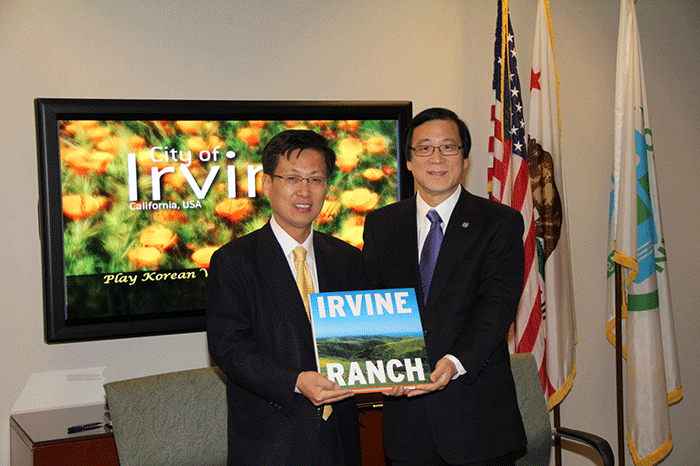
During the event, US$34.4 millions of flower export contracts, the highest so far, were signed. Countries involved included Japan, the Netherlands, the United States and Russia. By doing do, the flower export contracts signed during the flower show exceeded US$30 million every year during the past four years. Fifteen leading horticulture buyers from Japan, the United States, Russia, Taiwan, China and other countries were invited, a move that contributed to the increased export of flowers.
According to estimates by a university research group, the International Horticulture Goyang Korea 2014 produced KRW154.6 billion of economic effects, including KRW42.4 billion in value added and KRW4.3 billion in state taxes.
Goyang: A City of Warm-hearted People
Mayor Choi Sung of the Goyang City is making an all-out-effort to turn Goyang into a 'City of Warm-hearted people,' which is noted for a (1) residence-centered city, (2) warm welfare and education, (3) creative culture and art, (3) environment-friendly, green and peaceful surroundings and (4) self-sufficiency and satisfactory employment. Further details of the distinguishing features of the Goyang City are as follows:
Landmarks of the Goyang City:
Ilsan Lake ParkIt is the biggest man-made lake park in Asia which encompasses 1,157,000 square meters. It has a natural ecological system that may be difficult to experience in the middle of city. It is beloved by Goyang City residents for leisure and outing. The park features a large open square, artificial island, natural educational site, outdoor stage, exhibition of sculptures and more.
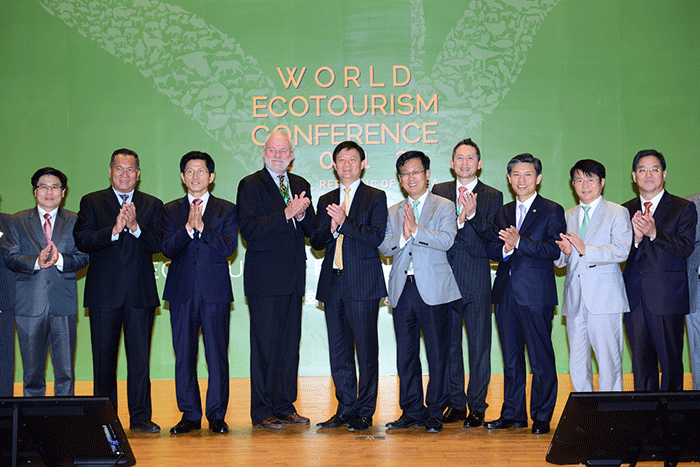
Mt. BukhanMt. Bukhan is one of Korea's most beautiful mountains in Korea. It is nicknamed 'Alps of Korea.' Millions of climbers and tourist visit the mountain in all seasons, spring, summer, fall and winter.
Underwater Scene StudioIt is the only underwater scene studio in Korea. Underwater scenes in movies, dramas and commercials can be filmed. The studio, which covers 25,480 square meters, has three water tanks of different sizes. Situated at the first floor are an artists' lounge, dressing room, waiting room, change room, shower booth and washrooms. A cafeteria, conference room and equipment are at the second floor.
KINTEX Being Korea's largest trading exhibition hall, KINTEX is a mecca of exhibitions of Korean and foreign industrial products. It has conducted many large-scale industrial exhibitions, including Seoul Motor Show. In addition to industrial exhibitions, KINTEX is getting the spotlight as a multi-cultural exhibition space. Concerts, drama festivals and conferences are held at the large-scale exhibition hall.
Latin American Cultural Center-Museum
The Latin American Cultural Center-Museum was established by former Ambassador Yi Bok -Hyeong, who served as a diplomat in Latin America for approximately 30 years, in an effort to raise awareness and understanding of the Latin American region among the Korean people. The center has a museum, art gallery and culture park. The museum showcases Latin American artifacts made of soil, stone and wood, masks and other folk art crafts of the Maya, Inca and Aztec. The art gallery features contemporary artwork pieces including paintings and sculptures by contemporary artists.
Historic Relics:
UNESCO World Heritage Royal TombsTombs for kings of Joseon Dynasty, including Seooreung and Seosamneung, are recognized as unique architectural and landscape forms reflecting Confucian and geomantic traditions, as well as the related funereal rituals that have been handed down to the present day. They were registered as UNESCO'S World Cultural Heritage Site in 2009.
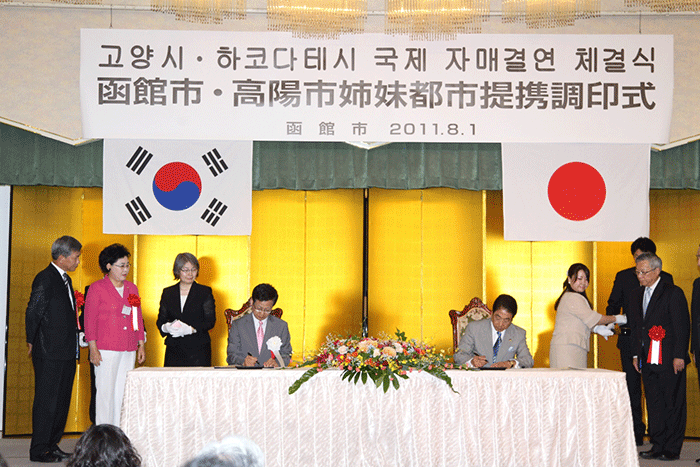
Seosamneung Royal TombSeosamneung is the name of the three royal tombs of Huireung, Hyoreung and Yereung. It is located in Deokyang-gu, Goyang. Huireung is the tomb of Queen Janggyeong, the second wife of King Jungjong, the 11th ruler of the Joseon Dynasty. The tomb is simple, surrounded only by ?anganseok,?stone railings, but the lotus flowers engraved on the railings make it very pleasant.
HyoreungHyoreung is the name of the tombs of King Injong, the 12th ruler, and Queen Inseong. The two graves are linked by a railing. The tombstones are engraved with clouds and the 12 animals of the Eastern zodiac. Yereung is the name of the tombs of King Cheoljong, the 25th ruler, and Queen Cheorin. The two graves are linked by a railing.
SeooreungSeooreung is composed of Gyeongneung, (the tomb of the posthumously designated rulers, King Deokjong and Queen Sohye), Changneung, (the tomb of King Yejong, the 8th ruler, and Queen Ansun), Hongneung, (the tomb of Queen Jeongseong, a consort to King Yeongjo, the 21st ruler), Ingneung (the tomb of Queen Ingyeong, a consort to King Sukjong) and Myeongneung (the tomb of King Sukjong, the 19th ruler, and his two wives, Queen Inhyeon and Queen Inwon).
Seooreung is the second largest royal burial site of the Joseon Dynasty after Donggureung. In Korean, the mausoleums of Kings and Queens are named 'Reung' or 'Neung', the tombs of Kings' parents, Crown Princes and Princesses are called 'Won,' and the tombs of princes and princesses are called 'Myo.' In addition to the five 'Reung's (the tombs of the Kings and Queens) in Seooreung, there are three 'Won's.

